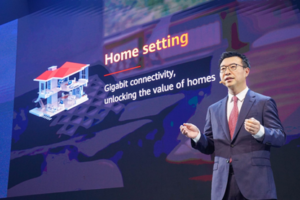
During UBBF 2022, Mr. Simon Lin, Senior Vice President of Huawei and President of Huawei Asia-Pacific Region, delivered a keynote speech entitled “Advanced Connectivity, Boost Growth”. In the speech, he set out a roadmap for how operators can unleash the full value of connections in home and enterprise scenarios and how green networks can underpin the green development of various industries.
Home setting: A smart home entry is built for gigabit broadband connections to achieve business monetization in home connection scenarios.
The upgrade of home networks and emergence of new services such as live streaming at home pose new requirements on gigabit broadband. Coupled with gigabit broadband, new services can provide users with diversified experiences, create new home network business models for operators, and enable connection monetization. Simon Lin introduced three ways to monetize home network connections:
- Gigabit to Home: Fast and large-scale deployment of optical fibers lays the foundation for operators to build a positive business cycle. Deploying optical fibers on a large scale can effectively reduce the cost per line and enable operators to launch gigabit services with higher average revenue per user (ARPU).
- Gigabit to Room: Huawei’s fiber to the room (FTTR) all-optical solution effectively addresses the challenge that only 100 Mbps bandwidth is available upon the subscription of gigabit to home, ensuring gigabit connections in each room. This solution also provides remote home network configuration and O&M capabilities to reduce operators’ maintenance costs by more than 50%. Good network and service experiences can ensure operators’ solution sales at a premium rate.
- Gigabit + Services: Operators can combine gigabit home networks with new services, such as providing scenario-specific broadband services, binding Internet services, and binding smart home device services. In this way, each new service can increase the ARPU of broadband services. Currently, operators have just begun to put into practice and expand new services based on optical fiber home networks, and the potential for further exploration in the future is limitless.
Enterprise setting: A connection entry is built for the digital transformation of enterprises to monetize their private lines and networks.
The digital transformation of traditional industries calls for connectivity upgrades. A variety of industries have different requirements for connectivity, driving operators to provide diverse enterprise network connection solutions. Currently, more and more enterprise services are migrating to the cloud, allowing operators to expand their business space. Simon Lin noted that operators can monetize enterprise-oriented connections in three ways:
- Bandwidth upgrade for private line services: Enterprise private lines are a high-value market for operators and can be used for covering campus networks and enterprise data center networks. The private line bandwidth is upgraded from Gbps to 10 Gbps to offer high-quality connections in and out of campuses and data centers.
- Scenario-specific differentiated solutions: Enterprises’ digital transformation requires diverse network connection services. Operators can provide scenario-specific private lines to increase revenues. For example, they can provide ultra-high-bandwidth private lines for the media industry, and millisecond-level low-latency private lines as well as security cloud services for securities companies.
- Upgrade from private lines to private networks: As many enterprise branches need to access multiple clouds, N x N private lines are required. Operators can use multi-cloud backbone and network slicing technologies to upgrade private lines to private networks, providing deterministic network assurance for enterprises.
Green solution: All-optical, simplified, and intelligent green networks enable the green development of various industries.
According to Simon Lin, Huawei is cooperating with operators to help the International Telecommunication Union-Telecommunication Standardization Sector (ITU-T) formulate standards and jointly define the network carbon intensity energy (NCIe) indicator system.
“A sculpture lies hidden within a marble block, but only the greatest artist can set it free,” said Simon Lin, pointing out that operators have inherent network advantages in connectivity and will bring unlimited interconnection value to the world if their connectivity capabilities are fully unleashed. He also stated that Huawei will continue to explore connectivity technologies and solutions with customers and partners, and work with operators to promote business growth.
Image caption: Simon Lin, Senior Vice President of Huawei and President of Huawei Asia-Pacific Region
